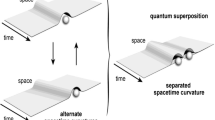Abstract
Eugene Wigner and others have speculated that the “collapse of the state vector” during an observation might be a physically real process so that some modification of current quantum theory would be required to describe the interaction with a conscious observer appropriately.
Experimental reports on the “psychokinetic effect” as a mental influence on the outcome of quantum jumps suggest that perhaps this effect might be vital for an understanding of the observer's role in quantum mechanics.
Combining these two speculations we introduce a reduction principle that provides for the gradual reduction of a macroscopically ambiguous state and allows simultaneously for the occurrence of some psychokinetic effect in the process of observation.
The resulting model leads to many of the paradoxical, but logically consistent, features of the psychokinetic effect that have been reported, and makes further testable predictions.
The model does not touch on the more profound questions of consciousness. But the model implies that the result of a conscious observation, the collapse of the state vector, becomes accessible to the experimenter, with the psychokinetic effect as probe: Whether Schrödinger's cat has not or has collapsed the state vector determines whether or not the later human observer can still exert a psychokinetic influence on the result.
Similar content being viewed by others
References
H. Schmidt,J. Appl. Physics 41, 462 (1970).
B. S. Dewitt and R. N. Graham,Am. J. Phys. 39, 724 (1971).
B. d'Espagnat,Conceptual Foundations of Quantum Mechanics (W. A. Benjamin, Inc., Reading, MA, 1976).
J. von Neumann,Mathematische Grundlagen der Quantenmechanik (Springer, Berlin, 1932); English translation:Mathematical Foundations of Quantum Mechanics (Princeton U. Press, Princeton, 1955); F. London and E. Bauer, La Théorie de l'Observation en Méchanique Quantique (Hermann, Paris, 1939).
E. P. Wigner, “Remarks on the Mind Body Problem.” inThe Scientist Speculates (Basic Books, Inc., New York 1962), pp. 284–302.
L. E. Rhine and J. B. Rhine,J. Parapsychology 7, 20 (1943).
L. E. Rhine,Mind Over Matter (Macmillan, N.Y., 1970).
J. Beloff and L. Evans,J. Soc. Psychical Res. 41, 41 (1961).
R. Chauvin and J. Genthon,Z. f. Parapsychologie und Grenzgebiete der Psychologie 8, 140 (1965).
H. Schmidt,New Scientist and Science Journal 24, 757 (June 1971).
H. Schmidt, “Evidence for Direct Interaction between the Human Mind and External Quantum Processes.” in1977 Proceedings of the International Conference on Cybernetics and Society. IEEE, Inc., New York.
B. Dunne, R. Jahn, and R. Nelson, “An REG Experiment with Large Data Base Capability.” inResearch in Parapsychology, (Scarecrow Press, Metuchen, N.J., 1981); R. G. Jahn,Proc. IEEE, Vol.70, No. 2, 136 (1982).
H. Schmidt,J. Am. Soc. Psychical Res. 70, 267 (1967).
H. Schmidt,Found. Phys. 8, 463 (1978).
E. H. Walker, “Foundations of Paraphysical and Parapsychological Phenomena.” inQuantum Physics and Parapsychology (Parapsychology Foundation, Inc., New York, 1974).
R. D. Mattuck and E. H. Walker, “The Action of Consciousness on Matter, a Quantum Mechanical Theory of Psychokinesis.” inThe Iceland Papers (Essentia Research Associates, Amherst, WI, 1979), pp. 111–159.
O. Costa de Beauregard,Psychoenergetics 4, 11 (1981).
G. Ludwig,Die Grundlagen der Quantenmechanik (Springer Verlag, Berlin, 1954).
H. Schmidt,J. Parapsychology 45, 87 (1981).
O. Costa de Beauregard,Found. Phys. 6, 539 (1976); O. Costa de Beauregard,Found. Phys. 10, 514 (1980).
Author information
Authors and Affiliations
Rights and permissions
About this article
Cite this article
Schmidt, H. Collapse of the state vector and psychokinetic effect. Found Phys 12, 565–581 (1982). https://doi.org/10.1007/BF00731929
Received:
Issue Date:
DOI: https://doi.org/10.1007/BF00731929



